An Autonomous Ultra-Wide Band-Based Attitude and Position Determination Technique for Indoor Mobile Laser Scanning
Abstract
1. Introduction
2. Background
2.1. Mobile Laser Scanning
2.2. UWB for Indoor Positioning
3. Proposed Method—UWB-Based Indoor Mobile Laser Scanning
4. Test of the Proposed Method
4.1. Results
4.2. Discussion
5. Conclusions and Further Research
Acknowledgments
Author Contributions
Conflicts of Interest
References
- Zhang, S.; Teizer, J.; Lee, J.K.; Eastman, C.M.; Venugopal, M. Building Information Modeling (BIM) and Safety: Automatic Safety Checking of Construction Models and Schedules. Autom. Constr. 2013, 29, 183–195. [Google Scholar] [CrossRef]
- Kaijaluoto, R.; Kukko, A.; Hyyppä, J. Precise Indoor Localization for Mobile Laser Scanner. ISPRS Int. Arch. Photogramm. Remote Sens. Spat. Inf. Sci. 2015, 1–6. [Google Scholar] [CrossRef]
- Bueno, M.; González-Jorge, H.; Martínez-Sánchez, J.; Lorenzo, H. Automatic point cloud coarse registration using geometric keypoint descriptors for indoor scenes. Autom. Constr. 2017, 81, 134–148. [Google Scholar] [CrossRef]
- Rogers, R.M. Applied Mathematics in Integrated Navigation Systems, 3rd ed.; American Institute of Aeronautics and Astronautics: Reston, VA, USA, 2007; pp. 103–113. [Google Scholar] [CrossRef]
- Grewal, M.S.; Andrews, A.P.; Bartone, C.G. Global Navigation Satellite Systems, Inertial Navigation, and Integration, 3rd ed.; John Wiley & Sons, Inc.: Hoboken, NJ, USA, 2013; ISBN 978-1-118-44700-0. [Google Scholar]
- Alarifi, A.; Al-Salman, A.; Alsaleh, M.; Alnafessah, A.; Al-Hadhrami, S.; Al-Ammar, M.; Al-Khalifa, H. Ultra Wideband Indoor Positioning Technologies: Analysis and Recent Advances. Sensors 2016, 16, 707. [Google Scholar] [CrossRef] [PubMed]
- Guo, H.; Fang, S.; Yu, M. A new indoor positioning method based on Zigbee system. In Proceedings of the 29th International Technical Meeting of the Satellite Division of the Institute of Navigation (ION GNSS+ 2016), Portland, OR, USA, 12–16 September 2016; pp. 816–821. [Google Scholar]
- Luoh, L. ZigBee-based intelligent indoor positioning system soft computing. Soft Comput. 2014, 18, 443–456. [Google Scholar] [CrossRef]
- Razavi, S.N.; Moselhi, O. GPS-less indoor construction location sensing. Autom. Constr. 2012, 28, 128–136. [Google Scholar] [CrossRef]
- Woo, S.; Jeong, S.; Mok, E.; Xia, L.; Choi, C.; Pyeon, M.; Heo, J. Application of WiFi-based indoor positioning system for labor tracking at construction sites: A case study in Guangzhou MTR. Autom. Constr. 2011, 3–13. [Google Scholar] [CrossRef]
- Zhao, R.; Zhong, B.; Zhu, Z.L.; Ma, L.; Yao, J.F. Overview of Indoor Localization Techniques and Applications. Electr. Sci. Technol. 2014, 27, 154–157. [Google Scholar]
- Retscher, G.; Fu, Q. Integration of RFID, GNSS and DR for Ubiquitous Positioning in Pedestrian Navigation. J. Glob. Position. Syst. 2007, 6, 56–64. [Google Scholar] [CrossRef][Green Version]
- Núñez-Andrés, M.A.; Buill, F.; Delgado-Medina, S.; Plancho-Milian, C. The use of geomatic techniques to improve the management of metro infrastructure. Surv. Rev. 2017. [Google Scholar] [CrossRef]
- Khoury, H.M.; Kamat, V.R. Evaluation of position tracking technologies for user localization in indoor construction environments. Autom. Constr. 2009, 18, 444–457. [Google Scholar] [CrossRef]
- Reimann, R.; Bestmann, A.; Ernst, M. Locating Technology for AAL Applications with Direction Finding and Distance Measurement by Narrow Bandwidth Phase Analysis. In Evaluating AAL Systems through Competitive Benchmarking, EvAAL 2012, Communications in Computer and Information Science; Chessa, S., Knauth, S., Eds.; Springer: Berlin/Heidelberg, Germany, 2013; Volume 362, pp. 52–62. [Google Scholar]
- Pirkl, G.; Lukowicz, P. Robust, low cost indoor positioning using magnetic resonant coupling. In Proceedings of the 2012 Association for Computing Machinery Conference Ubiquitous Computing/International Conference on Ubiquitous Computing (Ubicomp-2012), Pittsburgh, PA, USA, 5–8 September 2012; pp. 431–440. [Google Scholar]
- Dobrev, Y.; Reustle, C.; Pavlenko, T.; Cordes, F.; Vossiek, M. Mobile robot 6d pose estimation using a wireless localization network. In Proceedings of the 2016 IEEE MTT-S International Conference Microwaves for Intelligent Mobility (ICMIM), San Diego, CA, USA, 19–20 May 2016; pp. 1–4. [Google Scholar]
- RealEarth. Available online: www.realearth.us (accessed on 16 March 2018).
- Ju, H.; Park, S.Y.; Park, C.G. Pedestrian Dead Reckoning System Considering Actual Condition of the Foot-Mounted IMU. Microsoft Indoor Localization Competition, Technical Report. Available online: https://www.microsoft.com/en-us/research/wp-content/uploads/2016/11/Ju_SoyoungPark.pdf (accessed on 16 March 2018).
- Lymberopoulos, D.; Liu, J. The Microsoft Indoor Localization Competition: Experiences and Lessons Learned. IEEE Signal Process. Mag. 2017, 34, 125–140. [Google Scholar] [CrossRef]
- Elseberg, J.; Borrmann, D.; Nüchter, A. Algorithmic solutions for computing precise maximum likelihood 3D point clouds from mobile laser scanning platforms. Remote Sens. 2013, 5, 5871–5906. [Google Scholar] [CrossRef]
- Barber, D.; Mills, J.; Smith-Voysey, S. Geometric validation of a ground-based mobile laser scanning system. ISPRS J. Photogramm. Remote Sens. 2008, 63, 128–141. [Google Scholar] [CrossRef]
- Puente, I.; González-Jorge, H.; Martínez-Sánchez, J.; Arias, P. Review of mobile mapping and surveying technologies. Measurement 2013, 46, 2127–2145. [Google Scholar] [CrossRef]
- Lehtomaki, M.; Jaakkola, A.; Hyyppa, J.; Lampinen, J.; Kaartinen, H.; Kukko, A.; Puttonen, E.; Hyyppa, H. Object Classification and Recognition from Mobile Laser Scanning Point Clouds in a Road Environment. IEEE Trans. Geosci. Remote Sens. 2016, 54, 1226–1239. [Google Scholar] [CrossRef]
- Immersive 3D Spaces for Real-World Applications, Matterport. Available online: https://matterport.com/ (accessed on 16 March 2018).
- Bosse, M.; Zlot, R.; Flick, P. Zebedee: Design of a Spring-Mounted 3-D Range Sensor with Application to Mobile Mapping. IEEE Trans. Robot. 2012, 28, 1104–1119. [Google Scholar] [CrossRef]
- Navvis. Digitizing Indoors—NavVis. Available online: http://www.navvis.com (accessed on 16 March 2018).
- Leica Geosystems. Leica Pegasus: Backpack. Available online: http://www.leica-geosystems.com (accessed on 16 March 2018).
- Kaarta. Stencil. Available online: http://www.kaarta.com (accessed on 16 March 2018).
- Lehtola, V.V.; Virtanen, J.P.; Vaaja, M.T.; Hyyppä, H.; Nüchter, A. Localization of a mobile laser scanner via dimensional reduction. ISPRS J. Photogramm. Remote Sens. 2016, 121, 48–59. [Google Scholar] [CrossRef]
- Lehtola, V.V.; Virtanen, J.P.; Kukko, A.; Kaartinen, H.; Hyyppä, H. Localization of mobile laser scanner using classical mechanics. ISPRS J. Photogramm. Remote Sens. 2015, 99, 25–29. [Google Scholar] [CrossRef]
- Lauterbach, H.; Borrmann, D.; Heß, R.; Eck, D.; Schilling, K.; Nüchter, A. Evaluation of a Backpack-Mounted 3D Mobile Scanning System. Remote Sens. 2015, 7, 13753–13781. [Google Scholar] [CrossRef]
- Lehtola, V.V.; Kaartinen, H.; Nüchter, A.; Kaijaluoto, R.; Kukko, A.; Litkey, P.; Honkavaara, E.; Rosnell, T.; Vaaja, M.T.; Virtanen, J.-P.; et al. Comparison of the Selected State-Of-The-Art 3D Indoor Scanning and Point Cloud Generation Methods. Remote Sens. 2017, 9, 796. [Google Scholar] [CrossRef]
- Tanigawa, M.; Hol, J.D.; Dijkstra, F.; Luinge, H.; Slycke, P. Augmentation of low-cost GPS/MEMS INS with UWB positioning system for seamless outdoor/indoor positioning. In Proceedings of the 21st International Technical Meeting of the Satellite Division of the Institute of Navigation (ION GNSS 2008), Savannah, Georgia, 16–19 September 2008; pp. 1117–1124. [Google Scholar]
- Federal Communications Commission. First Report and Order 02-48; Federal Communications Commission: Washington, DC, USA, February 2002. Available online: https://transition.fcc.gov/Bureaus/Engineering_Technology/Orders/2002/fcc02048.pdf (accessed on 16 April 2018).
- Gezici, S.; Poor, H.V. Position estimation via ultra-wide-band signals. Proc. IEEE 2009, 97, 386–403. [Google Scholar] [CrossRef]
- Sahinoglu, Z.; Gezici, S.; Guvenc, I. Ultra-wideband Positioning Systems: Theoretical Limits, Ranging Algorithms, and Protocols; Cambridge University Press: Cambridge, UK, 2008; ISBN 0521873096. [Google Scholar]
- Maalek, R.; Sadeghpour, F. Accuracy assessment of Ultra-Wide Band technology in tracking static resources in indoor construction scenarios. Autom. Constr. 2013, 30, 170–183. [Google Scholar] [CrossRef]
- Shahi, A.; Aryan, A.; West, J.S.; Haas, C.T.; Haas, R.C.G. Deterioration of UWB positioning during construction. Autom. Constr. 2012, 24, 72–80. [Google Scholar] [CrossRef]
- Quan, Y.; Lau, L.; Wen, A.; Jing, F.; Nie, Q.; Cho, S.Y. Analysis and Machine-Learning based Detection of Outlier Measurements of Ultra-WideBand in an Obstructed Environment. In Proceedings of the IEEE 15th International Conference of Industrial Informatics 2017 INDIN’2017, Emden, Germany, 24–26 July 2017. [Google Scholar]
- Lau, L.; Cross, P.; Steen, M. Flight tests of error-bounded heading and pitch determination with two GPS receivers. IEEE Trans. Aerosp. Electron. Syst. 2012, 48, 388–404. [Google Scholar] [CrossRef]
- Underwood, J.P.; Hill, A.; Peynot, T.; Scheding, S.J. Error modeling and calibration of exteroceptive sensors for accurate mapping applications. J. Field Robot. 2010, 27, 2–20. [Google Scholar] [CrossRef]
- Bäumker, M.; Heímes, F.J. New Calibration and Computing Method for Direct Georeferencing of Image and Scanner Data Using the Position and Angular Data of an Hybrid Inertial Navigation System, OEEPE Work. 2001, pp. 1–17. Available online: http://www.hochschule-bochum.de/fileadmin/media/fb_v/veroeffentlichungen/baeumker/baheimesoeepe.pdf%0Ahttps://s3.amazonaws.com/mics.pix4d.com/KB/documents/baheimesoeepe.pdf (accessed on 1 January 2018).
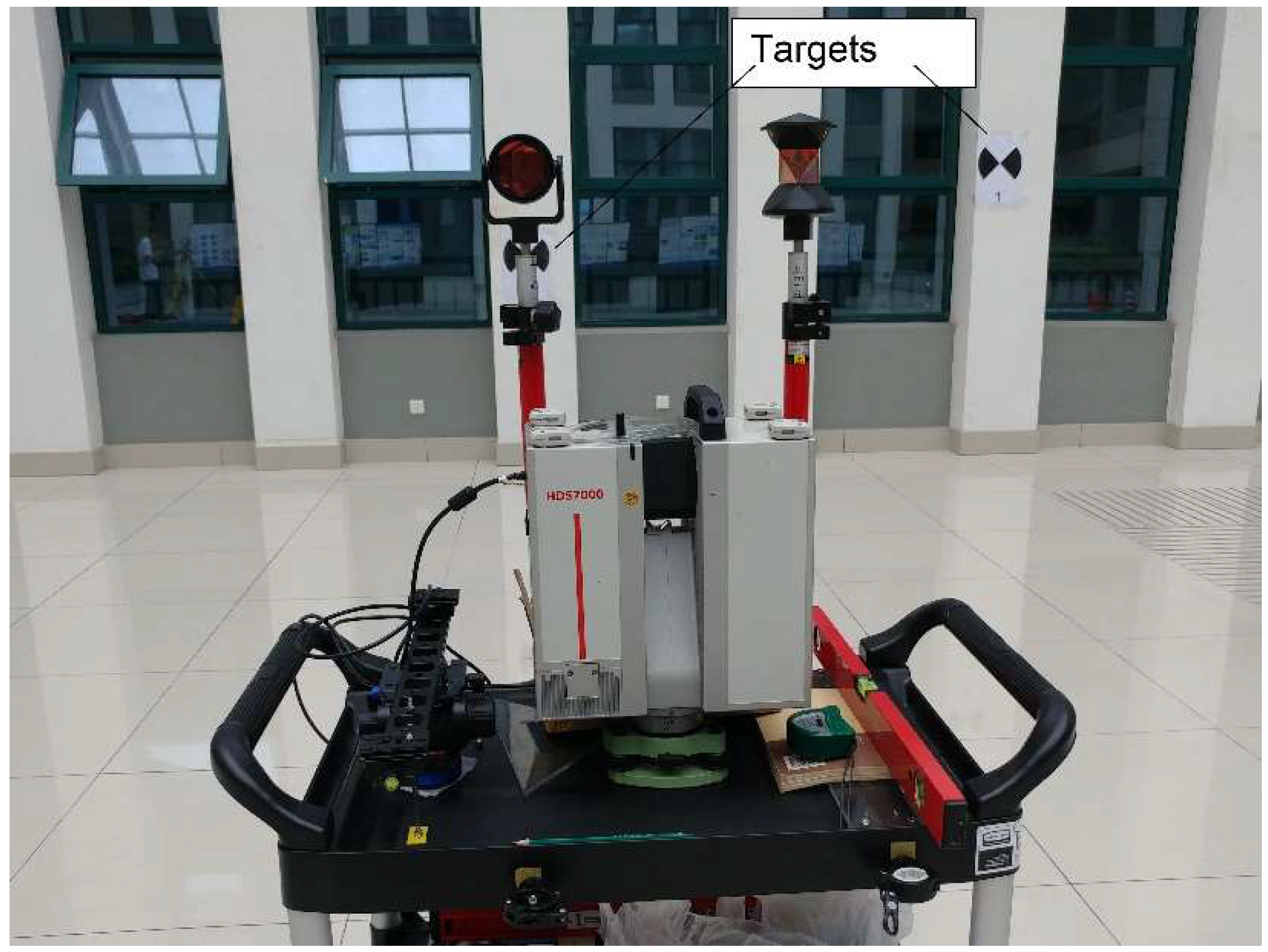
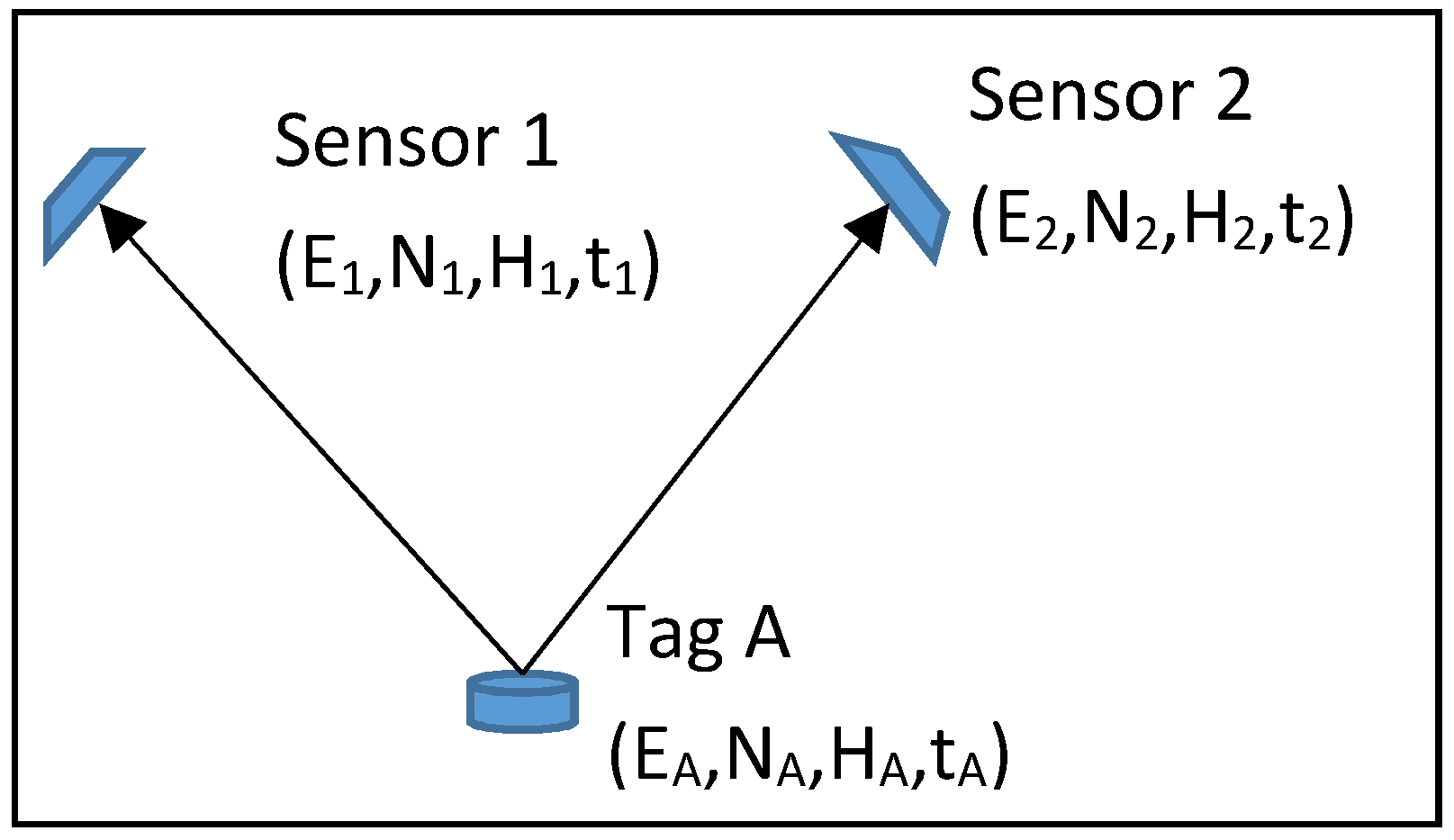
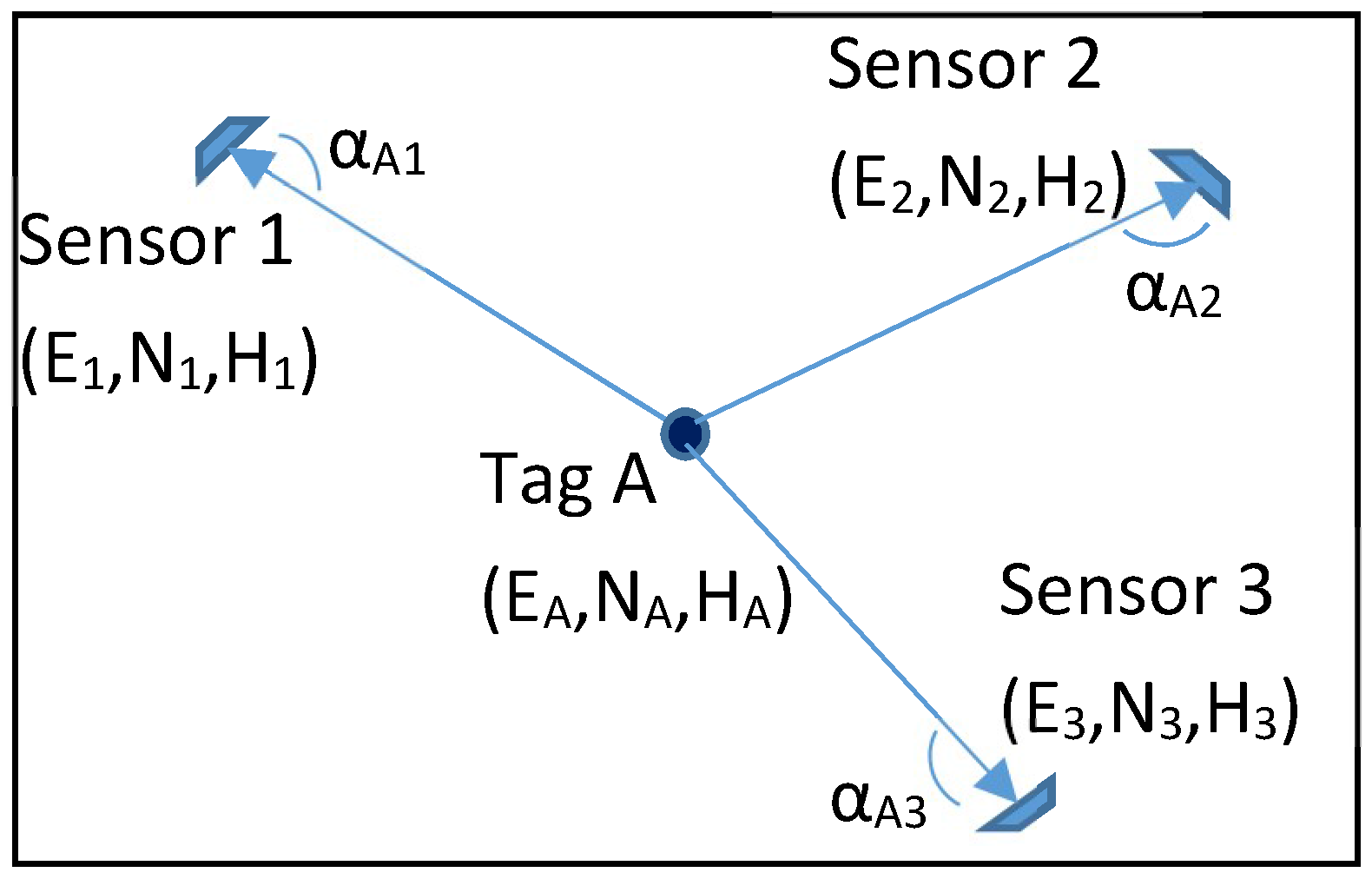
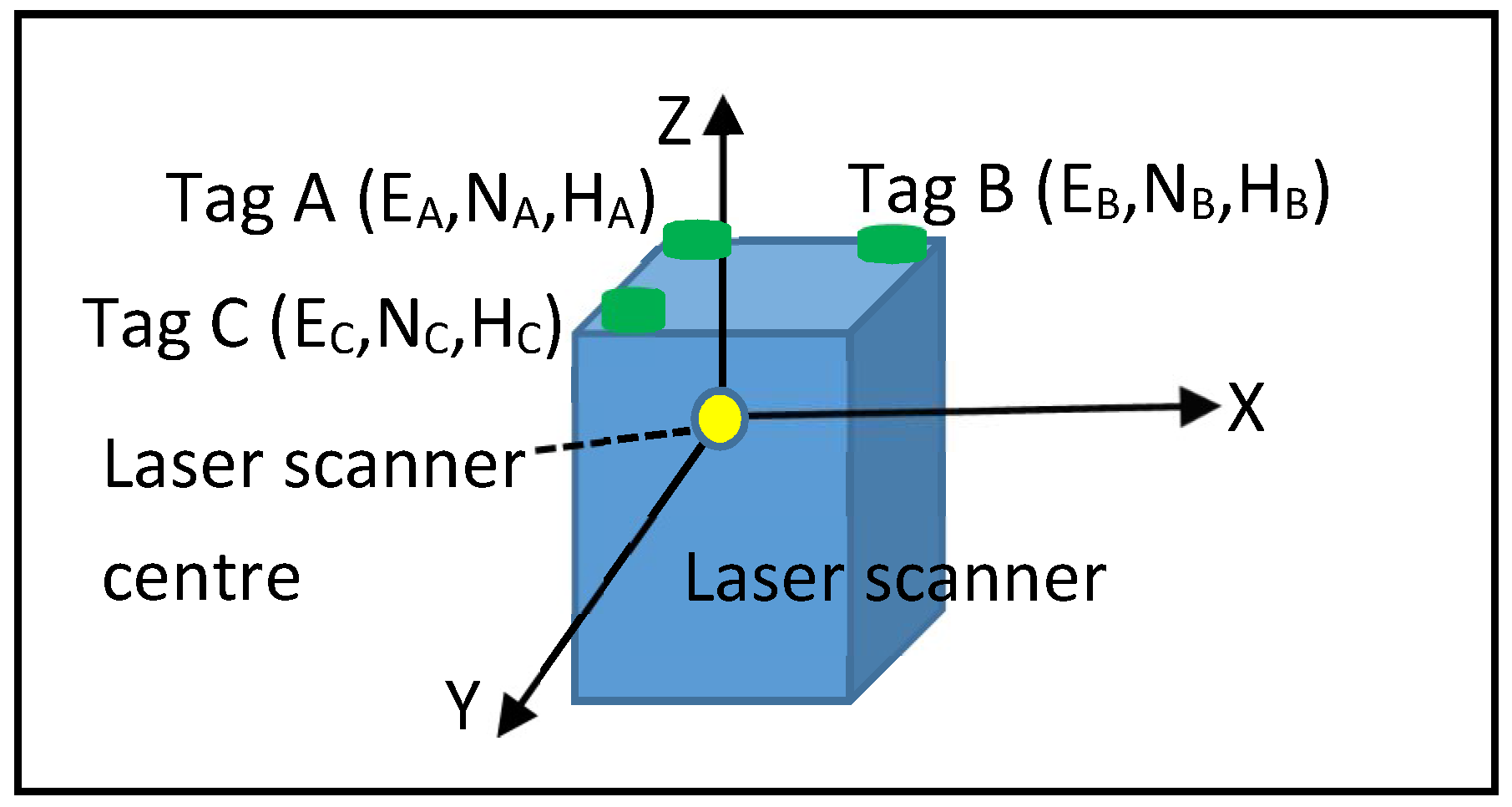
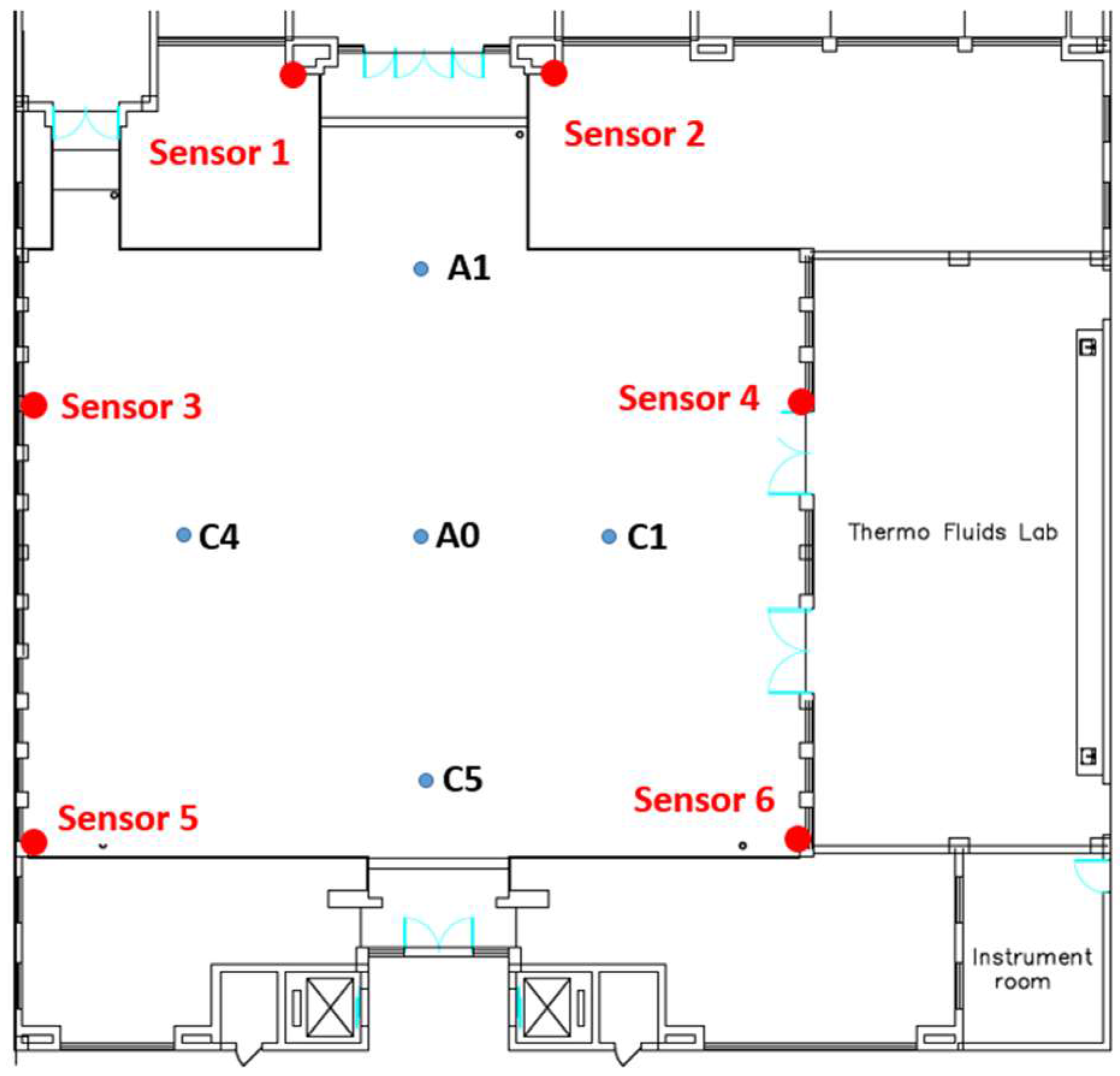
| Indoor Positioning Sensor | Accuracy | Line-of-Sight (LOS) Required | Measurement Type | Cost |
|---|---|---|---|---|
| Assisted-GNSS (A-GNSS) & High-Sensitivity (HS-GNSS) | 5–50 m | Yes | Time of Arrival (TOA), carrier phase | cheap |
| WLAN (WiFi) | 1–10 m | no | Received Signal Strength Indicator (RSSI) | cheap |
| Ultrasonic wave | 1–10 cm | no | TOA, Time Difference of Arrival (TDOA) | expensive |
| Infrared | 5–10 m | yes | Proximity, Differential Phase-shift, Angle of Arrival (AOA) | expensive |
| Bluetooth | 2–15 m | no | Proximity, RSSI | medium |
| RFID | 50 cm (passive)/2 m (active) | no | Proximity, RSSI | medium/cheap |
| Zigbee | 1–5 m | no | RSSI, Phase Shift Measurement | cheap |
| UWB | 10 cm–1 m | no | TOA, AOA, TDOA | expensive |
| Easting | Northing | Height | Horizontal | 3D | |
|---|---|---|---|---|---|
| RMSE (m) | 0.0942 | 0.0768 | 0.1932 | - | - |
| DRMSE (m) | - | - | - | 0.1215 | - |
| MRSE (m) | - | - | - | - | 0.2282 |
| Easting | Northing | Height | Horizontal | 3D | |
|---|---|---|---|---|---|
| RMSE (m) | 0.0009 | 0.0013 | 0.0014 | - | - |
| DRMSE (m) | - | - | - | 0.0016 | - |
| MRSE (m) | - | - | - | - | 0.0021 |
| Easting | Northing | Height | Horizontal | 3D | |
|---|---|---|---|---|---|
| RMSE (m) | 0.0812 | 1.5056 | 0.1681 | - | - |
| DRMSE (m) | - | - | - | 1.5078 | - |
| MRSE (m) | - | - | - | - | 1.5171 |
| Easting | Northing | Height | Horizontal | 3D | |
|---|---|---|---|---|---|
| RMSE (m) | 0.0417 | 0.7148 | 0.1852 | - | - |
| DRMSE (m) | - | - | - | 0.7160 | - |
| MRSE (m) | - | - | - | - | 0.7396 |
© 2018 by the authors. Licensee MDPI, Basel, Switzerland. This article is an open access article distributed under the terms and conditions of the Creative Commons Attribution (CC BY) license (http://creativecommons.org/licenses/by/4.0/).
Share and Cite
Lau, L.; Quan, Y.; Wan, J.; Zhou, N.; Wen, C.; Qian, N.; Jing, F. An Autonomous Ultra-Wide Band-Based Attitude and Position Determination Technique for Indoor Mobile Laser Scanning. ISPRS Int. J. Geo-Inf. 2018, 7, 155. https://doi.org/10.3390/ijgi7040155
Lau L, Quan Y, Wan J, Zhou N, Wen C, Qian N, Jing F. An Autonomous Ultra-Wide Band-Based Attitude and Position Determination Technique for Indoor Mobile Laser Scanning. ISPRS International Journal of Geo-Information. 2018; 7(4):155. https://doi.org/10.3390/ijgi7040155
Chicago/Turabian StyleLau, Lawrence, Yiming Quan, Jingjing Wan, Ning Zhou, Conghua Wen, Nie Qian, and Faming Jing. 2018. "An Autonomous Ultra-Wide Band-Based Attitude and Position Determination Technique for Indoor Mobile Laser Scanning" ISPRS International Journal of Geo-Information 7, no. 4: 155. https://doi.org/10.3390/ijgi7040155
APA StyleLau, L., Quan, Y., Wan, J., Zhou, N., Wen, C., Qian, N., & Jing, F. (2018). An Autonomous Ultra-Wide Band-Based Attitude and Position Determination Technique for Indoor Mobile Laser Scanning. ISPRS International Journal of Geo-Information, 7(4), 155. https://doi.org/10.3390/ijgi7040155






